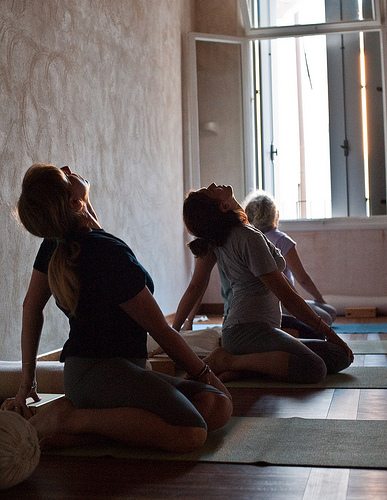One of the most indelible and defining moments in my training to become a yoga teacher began with a loud POP! At first, I thought it was my classmate’s back adjusting as our instructor led her into an advanced pose, but the look on her face said, “This is serious.”
Maybe she was predisposed to such an injury. Still, I couldn’t help but think that our teacher – naturally flexible and well-respected in the yoga community – was a little too attached to the student “getting” the pose.
Perhaps you’ve been in a yoga class where you sensed a competitive vibe or peer pressure to “keep up.” Or you’ve seen instructors who, without question, teach a “standard” routine, no matter the age or condition of the students. Or classes in which the teacher says to “listen” to your body and “adapt as you need to,” yet doesn’t show or tell you how. Or classes that move so quickly, you don’t have time to feel what’s happening in your body.
This is why I was so glad when I first saw William Broad’s New York Times piece on the risks of physical yoga poses, or asana, some years ago. (You’ll find the original article here and follow-up comment here.)
It’s something we regularly address in our Yoga Calm trainings – why we teach only simple poses that virtually everyone can benefit from; why we don’t teach inversions like headstand and shoulderstand; how muscular engagement protects joints and why observing the breath is such an important “stress gauge.” It’s why we had physical and occupational therapists peer review and help us write our book, Yoga Calm for Children.
But what’s missing from that NYT piece is something even more important: The purpose of yoga is more than just physical. Rather, the poses – and the context in which they’re taught – are fundamentally a means of developing self-awareness, character and social responsibility. We feel that such principles are at the heart of yoga – and many other contemplative practices – not how flexible your hamstrings are or how well you can perform the Downward Dog (or any other) pose.
At the same time, the article gives a misleading sense of risk. Millions of people now practice yoga. Compared with other recreational activities, the percentage of reported yoga injuries is incredibly small. Also, we should consider how many injuries yoga has helped prevent. Watch a sporting event, and you’ll see more than a few athletes now doing facilitated yoga stretches as part of their warm-up.
There are much bigger health risks that need to be addressed. One out of every 3 children born in the year 2000 is projected to develop diabetes. Stress and hypertension kill millions. Sitting at a computer for 8 to 10 hours a day causes more back problems than yoga.
These are some of the “physical” reasons why movement practices like Hatha yoga are needed.
In Yoga Calm, the practice is guided by five key principles we developed from more than three decades of educating children and equal time in various meditation and yoga practices. They’re the themes and goals that underlie all Yoga Calm processes and guide in their implementation:
From our book:
Historically, yoga practices have encompassed both physical and mental techniques for calming the nervous system—exactly what today’s stress researchers recommend. And while these techniques are an important part of yoga, they were designed to serve even greater purposes in the individual and the community—those of personal discovery, wellness, and self mastery. These overarching principles or philosophies of yoga invite creativity and flexibility in responding to needs; empower individuals through self-study, exploration, and discernment; and guide without dictating. The cultivation of these yogic attitudes is at the heart of yoga and a key determinant in its effectiveness, adaptability, and longevity.
Stillness
Stillness is the ability to quiet the mind and body; to be self-aware; to develop sensitivity, self control, and self-regulation.Listening
Listening is the ability to tune in to what the heart, mind, and body have to say. This is important for developing self-understanding, discrimination, self-regulation, and imagination. Appropriate listening reduces the chances of injury and self-destructive behavior.Grounding
Grounding is the ability to connect to the earth, to be physically present in the body, and to develop a sense of competence, physical safety, and security. A strong sense of balance and other healthy sensory-motor functions are building blocks for academic, behavioral, and emotional growth.Strength
Physical Strength helps prevent injury and disease and develops capability, confidence, and self-esteem based on measurable outcomes. Mental Strength is the use of positive self-talk, respecting boundaries, and monitoring the things taken into the mind and body. Emotional Strength is the ability to feel, identify, and express feelings without harming oneself or others. Emotional Strength is developed in the social/emotional processes and counseling strategies used in Yoga Calm.Community
Community nurtures the ability to give and receive support, as well as develop compassion, communication skills, and other abilities necessary to live cooperatively with others.
You can read more in Yoga Calm for Children.
This focus on principles lets Yoga Calm be readily adapted to many ages, abilities and environments. For example, in a classroom with students of diverse abilities, Stillness processes can be explored in a chair or while standing, Listening processes can be performed by all, and Community support can be displayed in many ways, such as simply giving attention, encouragement or respect.
In this way, “yoga” is much more than a pose. It becomes a tool, an approach and a perspective that can serve us throughout our entire lives.
Image by Augusto Mia Battaglia photography, via Flickr
Updated from the original



